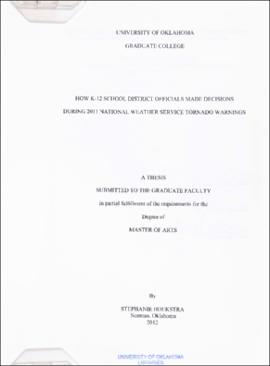| dc.description.abstract | School district officials are responsible for the safety of large populations of students and staff. Yet, few have meteorological training to accurately interpret severe weather information to make the best decisions during tornado warnings, and little research has focused on further understanding the context in which these groups make weather sensitive decisions. Including the needs and perspectives of groups such as school district officials into weather product development is necessary in order to create the most valuable and useful products in the future. Eleven participants with various titles from six school districts in central and eastern U.S. were interviewed in the spring and summer of 2011. Semi-structured interviews were used to address four main questions: 1) what is the K-12 public school official's time line of decision making and action implementation before, during, and after tornado warnings? 2) what sources of weather information do key decision makers in K-12 public schools access and why? 3) what are the non-weather factors that influence how decisions are made?, and 4) what types of weather information might improve operations for K-12 public schools, and how might longer lead times change the decision making process? Interviews were coded according to predete1mined themes and analyzed.
Preparations for tornado warnings, such as conducting drills, educating the students, and crafting severe weather plans, occurred during the majority of the year when there was no severe weather. Additionally, much of the action taken, most notably communicating with staff, students, and parents, occurs throughout several phases beginning hours before the severe weather was approaching to when the tornado warning has passed. "Lead time" in the minds of these decision makers thus began several hours before the tornado warning was issued, emphasizing the need to step away from the traditional mind set that a tornado warning lead time is only minutes before a tornado occurs. These decision makers used sources similar to what the general public is known to use, including NOAA websites, the television, and NOAA radios. Regardless of the severity of the weather, the majority of participants carried out their severe weather plans and sheltered students immediately after a tornado warning was issued for their district. Non-weather factors influenced how they perceived the warning and how students were brought into shelter, but they did not affect their decision of whether or not to shelter; taking shelter was an automatic response after a warning was issued. These participants prefer more spatial information with clear indication of whether or not the storm is likely to impact their district directly. Overall, participants found that extended tornado warning times would provide more time to go over plans and communicate with others, and recognized that this would require a modification of current warning plans and response. Several questioned whether a two-hour lead time would still bring the same sense of urgency as current warnings. This study shows that new meteorological advancements should respond to expressed needs of stakeholders. | |
